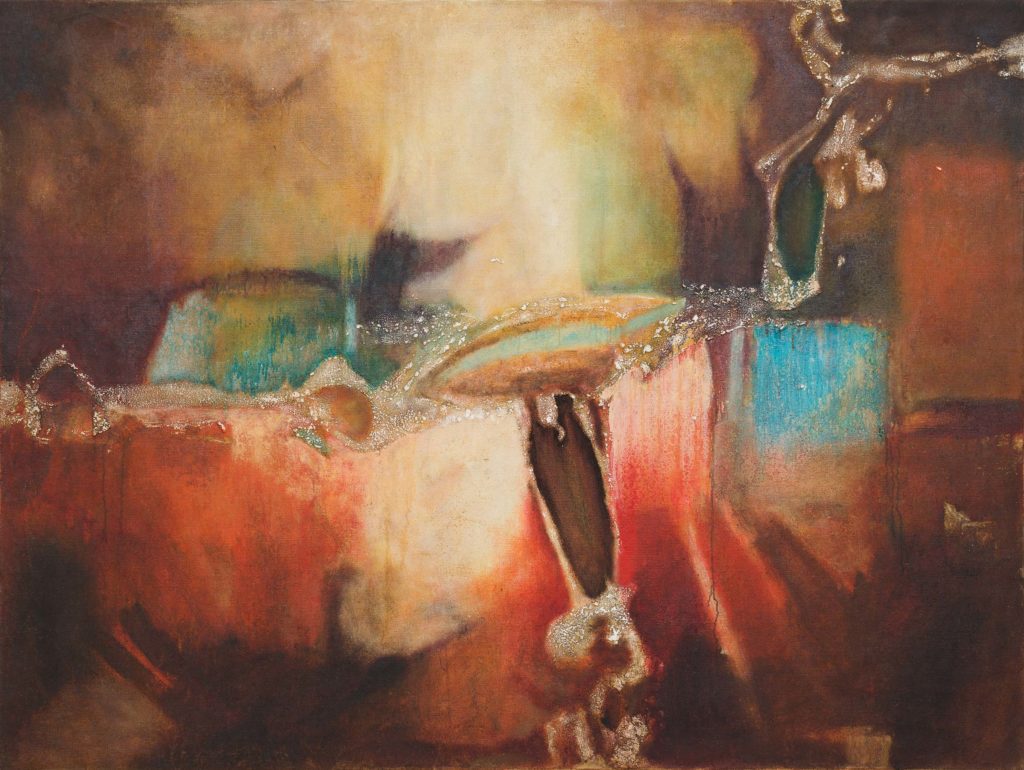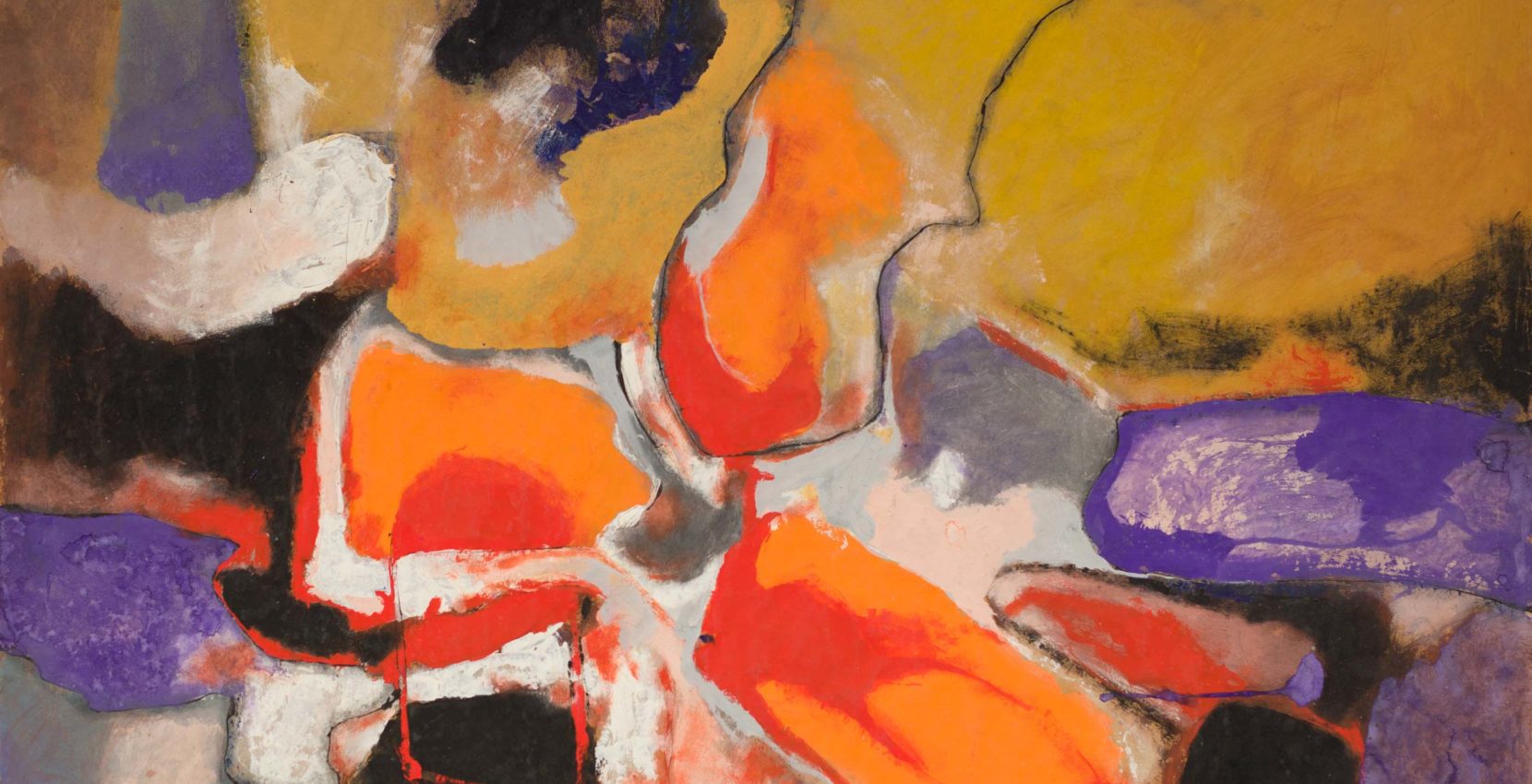How do we measure artistic importance. For those handling the legacy of artists like Aubrey Williams, there are many threads to weave. Stylistically his abstract technique swam in the same waters as the post-war Abstract expressionists such as Jackson Pollock, however his own output in that school emerged during the late ’50s but arguably reached the peak of their powers during the late 70s and early 80s. In which case his use symbology within abstraction has a mild resonance with the more famous Basquiat’s work at that time. So should we consider Williams ahead or behind the times? The answer, in either case, is contingent on how of these other, more famous, artists defined their time through compelling work and column inches detailing wild rebellious lives of shock, sex and violence – the necessary material for posterity in our current sensational age.
William’s social legacy with the Caribbean Artist’s Movement and the post-colonial project of challenging the idea of a ‘centre / periphery’ flow of ideas to something more flatly syncretic is hard to quantify. The broad discussion of when influence becomes imitative and whether ‘authenticity’ is a box or a badge of honesty can be read elsewhere, in Williams case we have a difficulty in that some of his works are presented within a social or geographic contexts when they weren’t necessarily created with those concerns in mind. Something that Williams’ himself contended with returning figurative elements later in his career as a reaction to “only making paintings […] like making wall furniture”. The extent to which his wrangling with the big issues in life made it onto the canvas and vice versa is up for grabs but undoubtedly he was an artist that took those challenges on and that places him in line with contemporary artistic debate.

Do we say that Williams is ‘woefully under-appreciated’? Is that the suitable hyperbolic thrust? The Tate have dedicated a room to him (open until may 2024) so he’s not disappeared entirely. Art and artists often have social matters in mind, and are socially active, but strain against any attempt to have influence foisted upon their actual work. We couldn’t say that all UK artist’s must name check Williams, not only because that would be weird, but also untrue. What we can do is ask what does Williams’ work artistically and otherwise say to us today? What were his responses to the very prescient problems he saw regarding power, economy and ecology and how were those responses expressed artistically and socially?
Abstract art often operate as physical objects, painted elements working spatially, gestural colour etc. Despite the non-figurative nature of the work there is a often an ur-figuration of material form as the basic building blocks of reality and perception. Where one can get lost in the overall effect but then also perceive the canvas’ creation story through painted layers, splotches, huge blocks of colour, In Williams’ Towakaima (1967) you see how he applied these forces in making the painting and how that leads to the overall effect. The title refer to a region of Guyana and for the Guyanese Williams who early in his career worked with local peoples in that region this place must itself have layers of significance. His experiences in that remote area would point to profound realisations about life the details of which we can read on paper but the depths of which are experienced as paths inward and forward on canvas. Technical expressions of a meaning system meant to be understood in the abstract.
Aubrey Williams: Future Conscious at October Gallery 12 June – 29th July 2023

Aubrey William: Future Conscious – Exhibition Notes
October Gallery presents Future Conscious, a solo exhibition comprising a selection of recently rediscovered paintings and works on paper by Aubrey Williams. The exhibition spans three decades — from the 1960s to the 1980s — and highlights Williams’ prescient understanding of, and concerns regarding, the mounting problems impacting environmental and ecological stability.
Williams, often cited as being ahead of his time, trained as an Agricultural Officer in Guyana in the early 1940s. He was finely attuned to the complexities of these interactive systems in ways that anticipated, by decades, our own recent awakening to the urgency and seriousness of the environmental crises now looming over humanity. Speaking, in 1978, of how his work addressed ‘the anxieties and tragedies of our time’, Williams said:
I know that the sea is now 38% polluted. We live off the sea, and we can’t now turn the clock back. It’s getting worse every day. Our resources of oxygen are shrinking, and can’t be reproduced. We have now also punctured the last source of oxygen, which is the South American Selvas [forests] by building that stupid road through the Amazonas. We have done colossal ecological damage…
Williams’ work can be viewed as a uniquely evolved expression of abstraction and as a powerful contribution to a post-war artistic sensibility. The works exhibited in Future Conscious show a striking and comprehensive use of colour, with a complex blend of abstraction and petroglyphic iconography.

There has recently been a major renewal of interest in Williams’ work as shown by his increasing prominence in significant international survey exhibitions, such as the seminal Fragments of Epic Memory at the Art Gallery of Ontario and Postwar Modern: New Art in Britain 1945–1965 at the Barbican, London, a timely reassessment of an artist whose distinctive body of work has frequently defied mainstream art conventions. Life Between Islands: Caribbean-British Art 1950s – Now at Tate Britain (2021–2022) positioned Williams’ work as a critical point of focus for the exhibition, juxtaposing seminal canvases alongside less familiar paintings. In another major exhibition, The Earth Will Open Its Mouth, Williams’ work was used as a revelatory counterweight, providing contrast and context alongside pieces by the surrealist, impressionist artist Erna Rosenstein at Museum Sztuki in Lodz, Poland.
Tate Britain has recently dedicated a room to Williams’ paintings, which is on display until 12th May, 2024.
As awareness of mankind’s destabilising impact on his environment increases in this newly defined Anthropocene age, there is a particular poignancy to this resurgence of interest in an important artist who was deeply engaged with these issues more than a half century ago.
Aubrey Williams: Future Conscious at October Gallery 12 June – 29th July 2023

The aim of art is to represent not the outward appearance of things, but their inward significance. – Aristotle



















